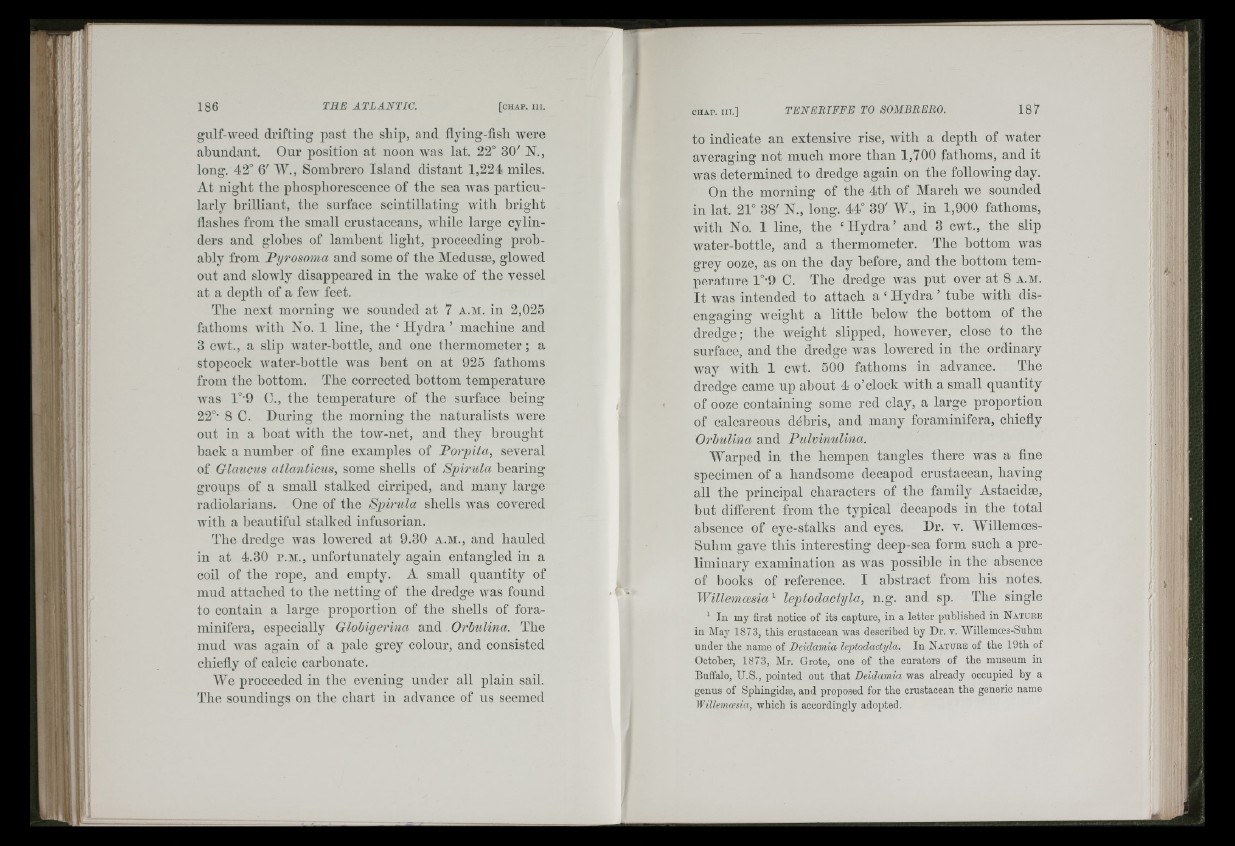
ite
186 TH E A T L A N T IC . [ c h a p . I I I .
w
gulf-Aveed drifting past the ship, and flying-fish were
abundant. Our position at noon was lat. 22° 30' N.,
long. 42° 6' AV, Sombrero Island distant 1,224 miles.
At night the phosphoreseenee of the sea ivas particularly
brilliant, the surface scintillating with bright
flashes from the small crustaceans, wdiile large cylinders
and globes of lambent light, proceeding probably
from Fyrosoma aud some of the Medusas, glowed
out and sloudy disappeared iu the wake of the vessel
at a depth of a few feet.
The next morning w'e sounded at 7 a.ai. in 2,025
fathoms wdth No. 1 line, the ‘ Hydra ’ machine aud
3 cwt., a slip w'ater-bottle, and one thermometer ; a
stopcock Avater-bottle Avas bent on at 925 fathoms
from the hottom. The corrected hottom temperature
AA'as 1°’9 0., the temperature of the surface being
22°- 8 C. During the morning the naturalists Avere
out iu a boat with the toAV-net, and they brought
hack a number of line examples of Forpita, several
of Glauctis atlanticus, some shells of Spirala bearing
groups of a small stalked cirriped, and many large
radiolariaus. One of the Spirula shells Avas covered
with a heautiful stalked infusorian.
The dredge was loAA'ered at 9.30 a.m., and hauled
iu at 4.30 P.AI., unfortunately again entangled iu a
coil of the rope, and empty. A small quantity of
mud attached to the netting of the dredge AA'as found
to contain a large proportion of the shells of foraminifera,
especially Glohigerina and Orhulina. The
mud AA'as again of a pale grey colour, aud consisted
chiefiy of calcic carbouate.
AA^e proceeded iu the evening under all plain sail.
The soundings ou the chart iu advance of us seemed
CHAP. I I I .] T E N E R IF F E TO SOMBRERO. 187
to indicate an extensive rise, Avith a depth of Avater
averaging not much more than 1,700 fathoms, and it
Avas determined to dredge again on tbe following day.
Ou the morning of the 4th of March we sounded
in lat. 21° 38' N., long. 44° 39' AV., in 1,900 fathoms,
Avith No. 1 line, the ‘Hydra’ and 3 cwt., the slip
water-hottle, aud a thermometer. The hottom was
grey ooze, as on the day before, and the hottom temperature
l°-9 C. The dredge Avas put over at 8 a.m.
It was intended to attach a ‘ Hydra ’ tuhe with disengaging
AA'eight a little heloAv the bottom of the
dredge; the weight slipped, however, close to the
surface, aud the dredge Avas loAvered in the ordinary
Avay Avith 1 cwt. 500 fathoms in advance. The
dredge came up about 4 o’clock Avith a small quantity
of ooze coutaiuing some red clay, a large proportion
of calcareous debris, and many foraminifera, chiefly
Orhulina and Pulvinulina.
AA"arped iu the hempen tangles there Avas a flue
specimen of a handsome decapod crustacean, having
all the principal characters of the family Astacidæ,
but different from the typical decapods in the total
absence of eye-stalks and eyes. Dr. v. AAhllemoes-
Suhm gave this interesting deep-sea form such a preliminary
examination as AA'as possible in the absence
of books of reference. I abstract from his notes.
Willemoesia^ leptodactyla, n.g. and, sp. The single
^ In my first notice of its capture, in a letter published in N a tu r e
in May 1873, this crustacean was described by Dr. v. Willemoes-Suhm
under the name of Beidamia leptodactyla. In N a tu r e of the 19th of
October, 1873, Mr. Grote, one of the curators of the museum in
Buffalo, U.S., pointed out that Deidamia was already occupied by a
genus of Sphingidæ, and proposed for the crustacean the generic name
Willemoesia, which is accordingly adopted.
1 Ilf